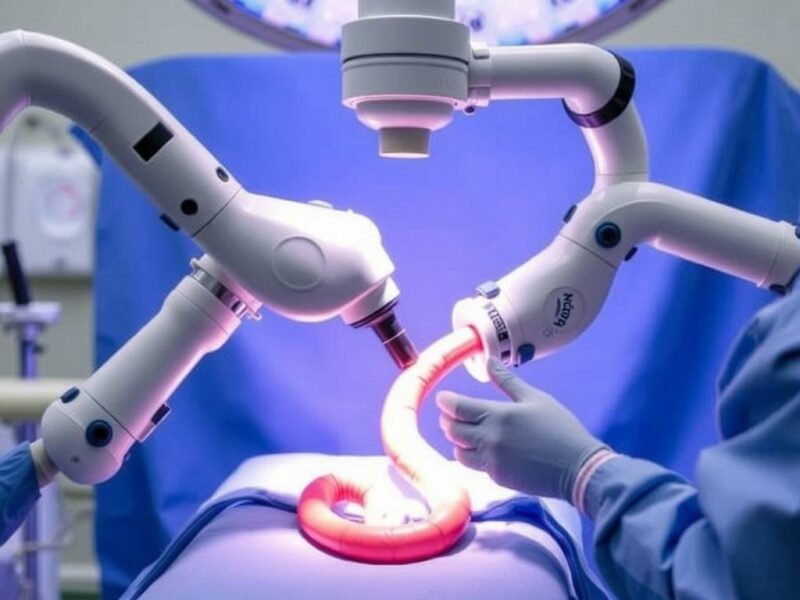Appendicitis, the inflammation of the appendix, is one of the most common surgical emergencies worldwide. Traditionally treated through open or laparoscopic appendectomy, the advent of robotic technology has introduced a revolutionary approach known as robotic appendectomy. This technique promises greater precision, reduced recovery time, and improved patient outcomes. In this comprehensive article, we will explore the ins and outs of robotic appendectomy, including how it works, its benefits and limitations, the surgical process, and what patients can expect before, during, and after the procedure.
What Is a Robotic Appendectomy?
A robotic appendectomy is a minimally invasive surgery that uses robotic technology to remove an inflamed appendix. It builds upon the principles of laparoscopic appendectomy but integrates advanced robotic arms, providing surgeons with enhanced dexterity and visualization. This procedure involves small incisions through which robotic instruments and a camera are inserted. The surgeon controls the robotic system from a console, translating their hand movements into precise actions inside the patient’s body.
Unlike traditional open surgery, which requires a large incision, or standard laparoscopic surgery, the robotic approach refines the surgeon’s ability to navigate around delicate tissues, reducing the risk of complications and promoting faster recovery. The key to this method lies in leveraging modern robotics to achieve superior outcomes while maintaining the minimally invasive nature of the treatment.
How Does Robotic Appendectomy Work?
The foundation of robotic appendectomy is the robotic surgical system, which typically consists of three components: the surgeon’s console, the patient-side cart with robotic arms, and a high-definition 3D vision system. Here’s how it works step by step:
- Patient Preparation: The patient is placed under general anesthesia, and small incisions are made in the abdomen.
- Docking the Robot: The robotic patient-side cart is positioned close to the patient, and robotic instruments are inserted through the incisions.
- Surgical Procedure: The surgeon sits at the console and controls the robotic arms with hand and foot controls, viewing the surgical area through a magnified, 3D image.
- Removal of the Appendix: The inflamed appendix is carefully dissected and removed with precision instruments.
- Closure: After appendectomy, the instruments and robot are withdrawn, and the incisions are closed with sutures or steri-strips.
This system allows unparalleled precision compared to human hands alone, minimizing tremors and enabling more natural motion within restricted body spaces.
Benefits of Robotic Appendectomy
The rise of robotic appendectomy is driven largely by the numerous advantages it offers over traditional surgical methods. Patients and surgeons alike benefit from this innovative approach in several ways:
| Benefit | Description |
|---|---|
| Enhanced Precision | Robotic instruments mimic the surgeon’s hand movements with incredible accuracy, reducing the risk of damage to surrounding tissues. |
| Improved Visualization | High-definition 3D cameras give surgeons a magnified view of the appendix and surrounding anatomy, improving safety and effectiveness. |
| Smaller Incisions | Robotic appendectomy uses tiny incisions, resulting in less pain and minimal scarring compared to open surgery. |
| Reduced Blood Loss | The enhanced precision leads to less trauma to blood vessels, thereby limiting intraoperative bleeding. |
| Faster Recovery | Patients undergoing robotic appendectomy often experience shorter hospital stays and quicker return to daily activities. |
| Lower Infection Risk | Smaller wounds and minimal tissue handling decrease the chance of postoperative infection. |
| Ergonomic Surgeon Experience | Surgeons benefit from the console setup that reduces fatigue, enhancing focus during lengthy or complex cases. |
Comparing Robotic Appendectomy with Traditional Appendectomy Methods
When evaluating robotic appendectomy, it’s important to understand how it stacks up against open and laparoscopic appendectomies. Each of these approaches has unique merits and challenges, which can influence the choice of technique depending on patient factors and surgeon experience.
Open Appendectomy
The open appendectomy has been the traditional approach for many years. It involves making a larger incision in the lower right abdomen to manually remove the appendix. While effective, it tends to result in longer recovery times, more postoperative pain, and a higher risk of wound infections and hernias.
Laparoscopic Appendectomy
This minimally invasive technique, which uses small incisions and a camera to guide instrument placement, has become the standard for many patients. Laparoscopic appendectomy reduces scarring, speeds up healing, and lowers complication rates compared to open surgery. However, it requires a high skill level, and in difficult cases, visibility and instrument maneuverability may be limited.
Robotic Appendectomy
Robotic appendectomy evolves the laparoscopic approach by adding robotic arms and improved visualization. Compared to standard laparoscopy, robotic surgery offers better ergonomics for the surgeon and enhanced instrument control, which can be especially beneficial in complex cases or patients with challenging anatomy.
| Feature | Open Appendectomy | Laparoscopic Appendectomy | Robotic Appendectomy |
|---|---|---|---|
| Incision Size | Large | Small (3-4 cm total) | Small (3-4 cm total) |
| Recovery Time | 7-14 days | 3-7 days | 2-5 days |
| Surgeon Ergonomics | Poor | Moderate | Excellent |
| Precision and Visualization | Limited | Good | Superior (3D, magnified) |
| Risk of Infection | Higher | Lower | Lowest |
Who Is a Candidate for Robotic Appendectomy?
Robotic appendectomy is generally suitable for most patients requiring removal of the appendix, but certain factors may influence candidacy:
- Severity of Appendicitis: While uncomplicated appendicitis is an ideal scenario, even some complicated cases, like abscesses or perforations, can be addressed robotically by experienced surgeons.
- Patient Health: Candidates must be fit for general anesthesia. Chronic illnesses or prior abdominal surgeries may be evaluated carefully.
- Age and Body Habitus: Robotic appendectomy can be performed on both pediatric and adult patients, including those with higher body mass indices where enhanced visualization offers an advantage.
- Availability of Equipment and Expertise: Access to robotic surgical systems and trained surgeons is essential.
The Robotic Appendectomy Procedure in Detail
Let’s walk through the entire robotic appendectomy process, from patient admission to discharge.
Before Surgery
Patients typically undergo diagnostic tests such as blood work, imaging studies like ultrasound or CT scans, and a physical examination. Once appendicitis is confirmed, the surgical team explains the procedure, risks, and benefits. Patients are instructed to fast before surgery and may receive antibiotics to reduce infection risk.
During Surgery
Under general anesthesia, the patient is positioned to allow access to the abdomen. A few small incisions, usually three, are made. Through these, trocars (hollow tubes) are inserted for the camera and instruments. The robotic system is then docked, and the surgeon controls the robotic arms from the console located near the operating table. Using the enhanced 3D view, the surgeon carefully isolates and removes the appendix. After ensuring no bleeding or leakage, the instruments and robotic arms are removed, and the incisions are closed.
After Surgery
Patients are monitored during recovery and usually experience less pain due to smaller incisions. Most are able to resume light activities within a few days and return to regular routines within a week. Physicians provide post-operative care instructions focused on wound care, pain management, and signs of potential complications.
Potential Risks and Limitations of Robotic Appendectomy

While robotic appendectomy is safe and effective for most patients, it is essential to consider inherent risks and limitations:
- Technical Complexity: Requires specialized training and experience to operate robotic systems effectively.
- Cost: The expense of robotic equipment and disposable instruments can make this approach more costly than traditional surgery, potentially limiting availability.
- Operative Time: Setting up and docking the robot may extend overall surgery time during the learning curve.
- Equipment Failure: Though rare, robotic system malfunctions can occur, necessitating conversion to laparoscopic or open surgery.
- Not Suitable for All Cases: Extensive inflammation or anatomical variations may prevent safe robotic access.
The Future of Robotic Surgery in Appendectomies
Robotic appendectomy represents a significant leap forward in the minimally invasive treatment of appendicitis, but continuous innovations are shaping what the future holds. Advances in robotic platforms aim to improve affordability, portability, and user-friendliness. Enhanced imaging techniques such as fluorescence-guided surgery promise to improve anatomical differentiation during the operation. Artificial intelligence integration might assist surgeons by providing real-time feedback or automating certain tasks.
As robotic surgery becomes more accessible globally, it is anticipated that robotic appendectomy will become more commonplace, further elevating surgical care standards and patient satisfaction.
FAQs About Robotic Appendectomy
| Question | Answer |
|---|---|
| Is robotic appendectomy painful? | Postoperative pain is generally mild due to small incisions and can be managed with over-the-counter pain medications. |
| How long does robotic appendectomy take? | The procedure typically lasts 45-90 minutes, though this varies based on case complexity and surgeon experience. |
| Are robotic appendectomy results better than laparoscopy? | While outcomes are comparable, robotic surgery offers improved precision, visualization, and surgeon comfort, potentially reducing complications in difficult cases. |
| When can I return to work after robotic appendectomy? | Most patients resume light work and daily activities within 1-2 weeks, depending on their recovery. |
| Will my insurance cover robotic appendectomy? | Coverage depends on the insurer and location. Patients should verify benefits with their provider and surgical team. |
Conclusion
Robotic appendectomy marks a transformative step in the treatment of appendicitis, combining the proven benefits of minimally invasive surgery with cutting-edge robotic technology. By offering enhanced precision, superior visualization, and faster healing, it creates a safer and more comfortable experience for patients and surgeons alike. While still evolving, this technique holds tremendous promise to become the new standard in appendectomy procedures worldwide. Whether you are a patient considering your surgical options or a healthcare professional seeking to understand modern advancements, robotic appendectomy represents the exciting future of surgical care—one where technology and skill unite to deliver the best possible outcomes.



